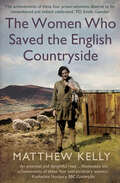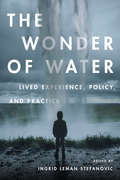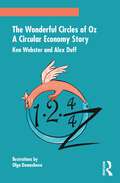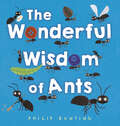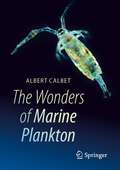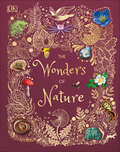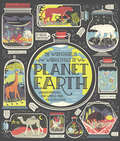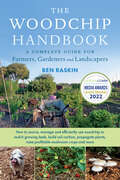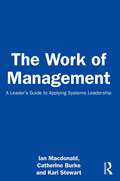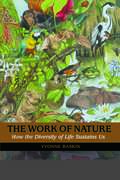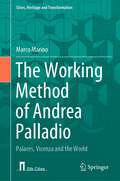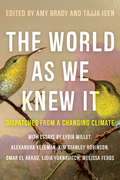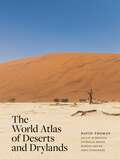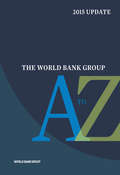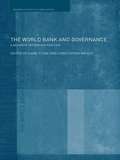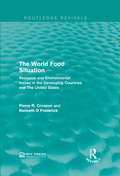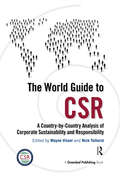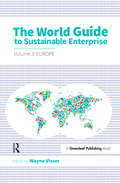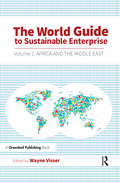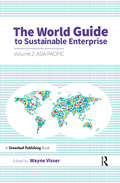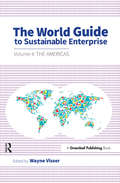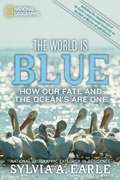- Table View
- List View
The Wolf: A True Story of Survival and Obsession in the West
by Nate BlakesleeA New Statesman Book of the Year The wolf stands at the forefront of the debate about our impact on the natural world. In one of the most celebrated successes of modern conservation, it has been reintroduced to Yellowstone National Park. What unfolds is a riveting multi-generational saga, at the centre of which is O-Six, a charismatic alpha female beloved by park rangers and amateur spotters alike. As elk numbers decline and the wolf population rises, those committed to restoring an iconic landscape clash with those fighting for a vanishing way of life; hunters stalk the park fringes and O-Six&’s rivals seek to bring an end to her dominance of the stunningly beautiful Lamar Valley.
The Wolves and Moose of Isle Royale: Restoring an Island Ecosystem (Scientists in the Field)
by Nancy F. CastaldoIn this exhilarating installment of the award-winning Scientists in the Field series, journey to the isolated islands of Isle Royale National Park where the longest predator/prey study in the world is being conducted along with a controversial genetic rescue to save not only the wolves and moose, but the entire island ecosystem.On Isle Royale, a unique national park more than fifty miles from the Michigan shore and about fifteen miles from Minnesota, a thrilling drama is unfolding between wolves and moose, the island’s ultimate predator and prey. For over sixty years, in what has been known as the longest study of predator and prey in the world, scientists have studied the wolves and moose of Isle Royale and the island’s ecology to observe and investigate wildlife populations. But due to illness and underlying factors, the population of wolves on the island has dropped while the number of moose has increased, putting the Isle Royale ecosystem in jeopardy.Now, for the first time ever, scientists are intervening. Join celebrated author Nancy Castaldo in this exciting journey to Isle Royale to document the genetic rescue experiment scientists there are embarking on. If they can successfully relocate twenty to thirty wolves from the mainland to Isle Royale, scientists can potentially restore the balance among wolves, moose, and trees of the island's ecosystem. Now the living laboratory experiment begins.
The Women Who Saved the English Countryside
by Matthew KellyA vibrant history of English landscape preservation over the last 150 years, told through the lives of four remarkable women In Britain today, a mosaic of regulations protects the natural environment and guarantees public access to green spaces. But this was not always so. Over the last 150 years, activists have campaigned tirelessly for the right to roam through the countryside and the vital importance of preserving Britain&’s natural beauty. Matthew Kelly traces the history of landscape preservation through the lives of four remarkable women: Octavia Hill, Beatrix Potter, Pauline Dower, and Sylvia Sayer. From the commons of London to the Lake District, Northumberland, and Dartmoor, these women protected the English landscape at a crucial period through a mixture of environmental activism, networking, and sheer determination. They grappled with the challenges that urbanization and industrial modernity posed to human well-being as well as the natural environment. By tirelessly seeking to reconcile the needs of particular places to the broader public interest they helped re-imagine the purpose of the English countryside for the democratic age.
The Wonder of Water: Lived Experience, Policy, and Practice (G - Reference, Information And Interdisciplinary Subjects Ser.)
by Ingrid Leman StefanovicFacing droughts, floods, and water security challenges, society is increasingly forced to develop new policies and practices to cope with the impacts of climate change. From taken-for-granted values and perceptions to embodied, existential modes of engaging our world, human perspectives impact decision-making and behavior. The Wonder of Water explores how human experience – from embodied cultural paradigms to value systems and personal biases – impact decisions around water. In many ways, the volume expands on the growing field of water ethics to include questions around environmental aesthetics, psychology, and ontology. And yet this book is not simply for philosophers. On the contrary, a specific aim is to explore how more informed philosophical dialogue will lead to more insightful public policies and practices. Case studies describe specific architectural and planning decisions, fisheries policies, urban ecological restorations and more. The overarching phenomenological perspective, however, means that these discussions emerge within a sensibility toward the foundational significance of human embodiment, culture, language, worldviews, and, ultimately, moral attunement to place.
The Wonderful Circles of Oz: A Circular Economy Story
by Alex Duff Ken WebsterWith the world’s economies impacted by coronavirus, billions are feeling social, environmental, and economic injustices. The call for a new, more just, more distributive economic story and system is louder and more urgent than ever. The Wonderful Circles of Oz provides both the framework and solutions for navigating towards an effective circular economy – the gateway to an abundant, autonomous, and democratic future. Widely regarded as one of the world’s most engaging circular economy thought leaders, Ken Webster, together with creative writer, Alex Duff, use a storytelling approach based on The Wonderful Wizard of Oz to offer a new, accessible, and compelling narrative about the future direction of our economy. ‘The harder you work, the more you’ll improve your lot.’ That’s the simple story we’ve been sold over the last 40 years to justify how today’s economy works. Yet extreme inequality, the devastation of our natural world, and the erosion of our communities tell us this economic story resembles a work of fiction and the way our extractive economy operates is not fit for purpose. Still a restoration narrative, a satisfying story about our future and how we’ll get there, is slow to emerge. Using allegory, commentary, and reflection, this book helps speed the shift from an extractive economy of materials, energy, and finance to one based on an effective circular economy, which builds wealth as a stock of solutions accessible to all. The Wonderful Circles of Oz goes beyond tired debates (capital vs labour and market vs state) and blends fiction and non to effectively communicate the need for macro-economic system redesign. Exploring complex change and containing echoes of modern monetary theory, this book is a must for business professionals, students, and anyone with an interest in the circular economy.
The Wonderful Wisdom of Ants
by Philip BuntingTake a peek under the rock, and discover what we can learn from the world of the ant, in this delightful blend of nonfiction and inspirational humor by author-illustrator Philip Bunting!There are ten quadrillion ants in the world, and yet I bet you never thought they could teach you anything. But these tiny creatures can do big things when they work together--just like people!With his signature humor and graphic illustrations, Philip Bunting delivers facts, laughs, and heart all in this special book that teaches that the answers to many of life&’s biggest questions can be found in your own back yard (once you&’re ready to look).
The Wonders of Marine Plankton
by Albert CalbetMarine plankton, despite their tiny size, are crucial for the functioning of marine food webs. It is not just about one organism eating another; when this happens, it helps release the nutrients accumulated within living matter, making them available again for microalgae. Plankton are present in freshwater and in all the seas and oceans on the planet. Moreover, they are responsible for supporting life on Earth and has provided us (on geological timescales) with a significant portion of the oxygen we breathe. In just a small spoonful of seawater, we can find around fifty million viruses, five million bacteria, hundreds of thousands of small unicellular flagellates, thousands of microscopic algae, five heterotrophic ciliates or dinoflagellates, and, with some luck, a small crustacean like copepods. This book aims to bridge the gap between scientific research and the general public, offering a captivating exploration of the fascinating world of marine plankton. Through engaging narratives and visually compelling illustrations, readers will gain insights into the importance of plankton in marine ecosystems, their diverse forms, and the crucial role they play in maintaining our planet's health.
The Wonders of Nature (DK Children's Anthologies)
by Ben HoareUncover awe-inspiring stories behind the natural world with this nature book for curious kids aged 6-8.The world is filled with curious objects such as amazing rocks and minerals, microscopic life, plants, animals and more. The wonders of wildlife are so much bigger than young minds can fathom and there is always more to learn! The Wonders of Nature is a stunning nature encyclopedia for young readers to explore, with reference pages packed with fascinating information, little learners will be captivated as they dive into this collection of 100 remarkableitems from the natural world, from orchids to opals and lichens to lizards and so much more! Each plant, animal, and rock is shown both photographically and illustrated, and children will love poring over the detailed close-up images. The storybook descriptions let you discover the myths and legends surrounding both organisms and gemstones, as well as key facts about their natural history. Find out how the prowling jaguar uses spots to avoid being spotted, why a sticky sundew means big trouble for insects, and what on Earth a radiolarian is. This beautiful treasury lets you find the things that interest you and uncover new favourites along the way. With reference pages packed with information you&’ll go away knowing something you didn&’t before, and you&’ll return time and again. The Wonders of Nature takes you on a tour of our planet through commonplace-but-incredible objects made by nature itself. The engaging storybook-style descriptions and simple text shed a light on the wonders of nature and wildlife, making this book ideal for inquisitive children aged 6-8 who loves to spot things when exploring outside and wants to know more about the wonderful and mysterious natural world.Celebrate your child&’s curiosity as they:- Explore 100 minerals, plants, and animals each with a stunning photographs and illustrations- Reveal fun facts in visual index guides that provide key reference information - Uncover captivating information on the natural history and mythology of a variety of nature&’s wonders This nature encyclopedia for children is the perfect blend of storybook style text with out of this world illustrations which makes it a fantastic nature book for children who are obsessed with wildlife and the natural world. Encourage young readers to go on a journey to explore a world of information, making this the ideal first reference book for kids aged 6-8 to enjoy for hours on end, whether reading with the family or reading alone, this fun fact book also doubles up as the perfect gift for curious kids who love to learn. Explore the vastness of space by uncovering: -Stunning Jacket Detail: gold foil, holographic foil & metallic gold edges-Striking photography & illustrations inside-A beautiful book for the whole family to treasure -A quality gift to be passed down through the generationsMore in the SeriesThe Wonder&’s of Nature is part of the beautiful and informative Anthology series. Complete the series and nurture your child's curiosity as they explore the natural world with Nature&’s Treasures or let them walk with the dinosaurs who ruled the earth before them in Dinosaurs and other Prehistoric Life.
The Wondrous Workings of Planet Earth: Understanding Our World and Its Ecosystems
by Rachel IgnotofskyAn illustrated tour of the planet exploring ecosystems large and small, from reefs, deserts, and rainforests to a single drop of water—from the New York Times best-selling author of Women in Science. Making earth science accessible and entertaining through art, maps, and infographics, The Wondrous Workings of Planet Earth explains how our planet works—and how we can protect it—from its diverse ecosystems and their inhabitants, to the levels of ecology, the importance of biodiversity, the cycles of nature, and more. Science- and nature-loving readers of all ages will delight in this utterly charming guide to our amazing home.
The Woodchip Handbook: A Complete Guide for Farmers, Gardeners and Landscapers
by Ben RaskinThe first and only complete guide to sourcing and using woodchip—an abundant, inexpensive, and ecologically sustainable material—for savvy growers and landscapers at any scale, from farm to garden to greenhouse. The Woodchip Handbook is the essential guide to the many uses of woodchip both in regenerative agriculture and horticulture. Author Ben Raskin, Head of Horticulture and Agroforestry at the Soil Association, draws on his extensive practical experience using woodchip, provides the latest research from around the world, and presents inspiring case studies from innovative farmers. The book explores and unlocks the tremendous potential of woodchip to enhance soil health and plant growth: As a natural mulch for weed suppression, temperature buffering, and water conservation As a growing medium for propagating plants As a decomposing source of warmth for hotbeds in the greenhouse or hoop house As a carbon-rich compost ingredient that supports beneficial fungi and microorganisms As a powerful soil health booster, when applied as small-sized ramial chipped wood As an ideal substrate for growing many kinds of edible or medicinal mushrooms As a sustainable, versatile, and durable material for foot paths and ornamental landscaping Some of these techniques, like mulching—or the renewable harvest potential from coppicing and pollarding trees—have been around forever. Yet there is always new science to be discovered, such as the role that salicylic acid from willow woodchip can play in preventing tree diseases or promoting livestock health when used as a bedding material. Whether you are a commercial grower or farmer, a permaculture practitioner, or a serious home gardener producing your own fruit and vegetables, The Woodchip Handbook will show you how to get the most out of this readily available and renewable material.
The Work of Management: A Leader’s Guide to Applying Systems Leadership
by Ian Macdonald Catherine Burke Karl StewartThe Work of Management demonstrates how the concepts, models and tools of Systems Leadership can be applied, enabling you to become a more effective manager by improving your own work to create a more positive and effective organisation.Positive organisations, where people come together to achieve a productive and personally satisfying purpose, and which provide the basis for a good society, do not occur by chance. They are created by the work of leaders and members who are dependent upon the way the organisation is designed and operates – its structure and systems. While the theory is explained, this book primarily presents the practical aspects – the specific values, methods and tools – that can be used to improve work and the work performance of direct reports. Building on the bestselling book Systems Leadership, this book provides leaders with a manual for the application of concepts as well as an introduction to Systems Leadership Theory, a method that has been used successfully by businesses from large multinational firms and banks, to SMEs, public agencies and NGOs. It provides a predictive capability, allowing a leader to predict what will work well and what is likely to fail, according to the context. It gives the benefit of foresight as decisions must be made.Designed as a leader’s manual for the application of the concepts around Systems Leadership, this book is for people who want to improve their own, and their organisation’s, work practices and performance.
The Work of Nature: How The Diversity Of Life Sustains Us
by Paul R. Ehrlich Harold A. Mooney Abigail Rorer Yvonne Baskin Jane Lubchenco"We do not question that flesh and bone and leaf litter will decay to dust, that seeds will sprout season after season and find renewed nourishment in the soil, that rivers can flow endlessly without running dry, that we can breathe a lifetime without depleting the air of oxygen.... What humans have not fully appreciated until recently is that these services are the work of nature, performed by the rich diversity of microbes, plants, and animals on the earth." --from The Work of NatureThe lavish array of organisms known as "biodiversity" is an intricately linked web that makes the earth a uniquely habitable planet. Yet pressures from human activities are destroying biodiversity at an unprecedented rate. How many species can be lost before the ecological systems that nurture life begin to break down?In The Work of Nature, noted science writer Yvonne Baskin examines the threats posed to humans by the loss of biodiversity. She summarizes and explains key findings from the ecological sciences, highlighting examples from around the world where shifts in species have affected the provision of clean air, pure water, fertile soils, lush landscapes, and stable natural communities.As Baskin makes clear, biodiversity is much more than number of species -- it includes the complexity, richness, and abundance of nature at all levels, from the genes carried by local populations to the layout of communities and ecosystems across the landscape. Ecologists are increasingly aware that mankind's wanton destruction of living organisms -- the planet's work force -- threatens to erode our basic life support services. With uncommon grace and eloquence, Baskin demonstrates how and why that is so.Distilling and bringing to life the work of the world's leading ecologists, The Work of Nature is the first book of its kind to clearly explain the practical consequences of declining biodiversity on ecosystem health and function.
The Working Method of Andrea Palladio: Palaces, Vicenza and the World (Cities, Heritage and Transformation)
by Marco MarinoThis book shows through historical data, diagrams and drawings, the design system of an Italian historic center, that of Vicenza, Italy. Vicenza is the result of an urban construction process that has as its model the invention of the Palladian design system. The main argument is how the architectural vision of Andrea Palladio shaped Vincenza to the city it is today. Vicenza is an example of a collective dream, an expression of the best Renaissance artistic culture, a classic example that a city can reform itself through intellectual activity.
The World As We Knew It: Dispatches From a Changing Climate
by Amy Brady and Tajja IsenNineteen leading literary writers from around the globe offer timely, haunting first-person reflections on how climate change has altered their lives—including essays by Lydia Millet, Alexandra Kleeman, Kim Stanley Robinson, Omar El Akkad, Lidia Yuknavitch, Melissa Febos, and moreIn this riveting anthology, leading literary writers reflect on how climate change has altered their lives, revealing the personal and haunting consequences of this global threat. In the opening essay, National Book Award finalist Lydia Millet mourns the end of the Saguaro cacti in her Arizona backyard due to drought. Later, Omar El Akkad contemplates how the rise of temperatures in the Middle East is destroying his home and the wellspring of his art. Gabrielle Bellot reflects on how a bizarre lionfish invasion devastated the coral reef near her home in the Caribbean—a precursor to even stranger events to come. Traveling through Nebraska, Terese Svoboda witnesses cougars running across highways and showing up in kindergartens. As the stories unfold—from Antarctica to Australia, New Hampshire to New York—an intimate portrait of a climate-changed world emerges, captured by writers whose lives jostle against incongruous memories of familiar places that have been transformed in startling ways.
The World Atlas of Deserts and Drylands
by David Thomas, Sallie Burrough, Nicholas Drake, Marion Meyer, and Troy SternbergA richly illustrated atlas of the world&’s deserts and drylands, their ecosystems, and their environmentsDeserts and drylands account for more than 40 percent of land on our planet. Characterized by a lack of water and extreme temperatures, they are the result of atmospheric stability, large landmass characteristics, rain shadows, and cold ocean currents. They appear harsh and hostile, but deserts and drylands are also exceptionally beautiful environments. Desert ecosystems often teem with diverse forms of life that exhibit astonishing ingenuity in the face of such forbidding conditions. The World Atlas of Deserts and Drylands takes readers on a guided tour of some of the most awe-inspiring desert environments on Earth, explaining their environmental and ecological dynamics and describing the techniques used to categorize and map them. From the ever-expanding Gobi of Mongolia and China to the ancient Namib of coastal Africa, this is the ultimate reference book for deserts.Features a wealth of color photos, maps, and infographicsDescribes the resilient and complex biodiversity of the world&’s desert and dryland terrainsCovers subtropical deserts, continental deserts, rain shadow deserts, and ocean margin desertsAddresses the challenges posed by global warming and human activity, and discusses solutions and opportunitiesWritten by a team of leading experts
The World Bank Group A to Z
by World Bank GroupThe World Bank Group A to Z provides the most concise and essential information about the mission, policies, procedures, products, and services of the new World Bank Group. With more than 280 entries arranged in encyclopedic A-to-Z format, readers can easily find up-to-date information about the five agencies of the World Bank Group and the wide range of areas in which they work: from agriculture, education, energy, health, social protection, and labor to gender, jobs, conflict, private sector development, trade, water, and climate change. The World Bank Group's work in all of these areas now focuses on two new twin goals: eliminating extreme poverty by 2030 and boosting shared prosperity of the poorest 40 percent in every developing country. Building on previous editions of A Guide to the World Bank, this new volume has been completely revised and updated to include features not found in its predecessors including, at the start of the book, a graphical introduction to the World Bank Group, highlighting the Bank Group's goals, financials, regions, and results; examples and photos of Bank Group projects and programs; and tools to guide you to the information you are looking for (even if you don't know exactly what that is). It also reflects the wideranging reforms that have taken place within the World Bank Group in recent years, including the launch of the new World Bank Group Strategy; new approaches to development; the establishment of new Global Practice Groups and Cross Cutting Solutions Areas; and the goal of becoming a "Solutions Bank," one that will marshal the vast reserves of evidence and experiential knowledge across the five World Bank Group agencies and apply them to local problems.
The World Bank and Governance: A Decade of Reform and Reaction (Routledge Studies in Globalisation)
by Christopher Wright Diane StoneThis timely book offers the first critical examination of World Bank policy reforms and initiatives during the past decade. The World Bank is viewed as one of the most powerful international organizations of our time. The authors critically analyze the influence of the institution’s policy and engagement during the past decade in a variety of issue areas, including human rights, domestic reform, and the environment. The World Bank and Governance delves into the bowels of the World Bank, exploring its organizational structure, professional culture and bureaucratic procedures, illustrating how these shape its engagement with an increasingly complex, diverse and challenging operational environment. The book includes chapters on two under-researched divisions of the World Bank: the International Finance Corporation and the Multilateral Investment Guarantee Agency. Several illuminating country studies are also included, analyzing the World Bank's activities in Argentina, Bolivia, Lebanon, Hungary and Vietnam. This volume will be of great interest to students and scholars of international relations, development, politics and economics.
The World Food Situation: Resource and Environmental Issues in the Developing Countries and The United States (Routledge Revivals)
by Pierre R. Crosson Kenneth D FrederickAt the beginning of the 1970’s, global grain reserves were level and food prices were low however as the decade progressed crop production plummeted leading to a food crisis. Originally published in the aftermath in 1977, Crosson and Frederick set out to explore the ability of agricultural output to meet the global food demands of future generations. This study analyses how resources and environmental factors would affect food production in developing countries and the United States until the end of the 21st Century. The environmental impacts of land levels, fertiliser and pesticide use are explored in relation to the challenges of meeting food demands. This title will be of interest to students of environmental studies.
The World Guide to CSR: A Country-by-Country Analysis of Corporate Sustainability and Responsibility
by Nick Tolhurst Wayne VisserThe World Guide to CSR is the first book to provide comparable national profiles that describe the evolution and practice of Corporate Sustainability and Responsibility (CSR) for 58 countries and 5 global regions. Each regional and national profile includes key information about the relevant CSR history, country-specific issues, trends, research and leading organizations. The purpose of the book is to give CSR professionals (including managers, consultants, academics and NGOs focusing on the social, environmental and ethical responsibilities of business) a quick reference guide to CSR in different regional and national contexts. The need for the book is premised on the fact that CSR professionals and researchers more often than not have a multinational remit and are required to benchmark performance internationally, but find that country-specific CSR information is ad hoc, limited or non-existent. Even where national CSR research exists, it is often hidden in academic journals that practitioners cannot access or do not have the time or inclination to read. The book is an edited volume, with expert contributors from around the world, all of whom have been screened and selected on the basis of their qualifications and experience in CSR. Each regional/country profile includes the following subsections:CSR in context Priority issues Trends Legislation and codes Organizations Case studies Educational institutions References This unique resource will be an essential acquisition for all organisations who need to benchmark their CSR strategies throughout different regions and cultures and want the best possible intelligence on the key issues and concerns relating to corporate social responsibility in all of the markets in which they operate.
The World Guide to Sustainable Enterprise - Volume 3: Europe
by Wayne VisserThe World Guide to Sustainable Enterprise is the first comprehensive global compendium that clearly describes the national approaches to sustainable enterprise. Through a systematic review of each country, this quick-to-access reference guide showcases the similarities and differences in each region. Every country profile includes key information about the relevant history, country-specific issues, trends, research, and the leading organizations operating in the field as well as best-practice case studies. The guide comprises four volumes, each dedicated to a specific region of the world. In a world where organizations are working increasingly across national and regional boundaries and research takes a joined-up and international approach, this book is an essential guide for practitioners and researchers in the disciplines of business sustainability, social enterprise and corporate responsibility. The first of its kind, this reference book provides the reader with a unique insight into what is the current state-of-play in each country. Each edited volume provides expert contributions from around the world; the contributors have been selected on the basis of their knowledge of the country and their clear experience in sustainable enterprise. Each regional/country profile includes the following subsections: Sustainable Enterprise in context; Priority issues; Trends; Government policies; Case studies; Further resources; and References. This unique resource will be an essential acquisition for all organizations who need to benchmark their sustainable enterprise strategies throughout different regions and cultures and want the best possible intelligence on the key issues and concerns relating to sustainable business and social responsibility in all of the markets in which they operate. It provides a useful companion reference collection to the World Guide to CSR, also edited by Wayne Visser. The full Four Volume Set of The World Guide to Sustainable Enterprise is available for purchase as a single item at a 25% discounted rate.
The World Guide to Sustainable Enterprise: Volume 1: Africa and Middle East
by Wayne VisserThe World Guide to Sustainable Enterprise is the first comprehensive global compendium that clearly describes the national approaches to sustainable enterprise. Through a systematic review of each country, this quick-to-access reference guide showcases the similarities and differences in each region. Every country profile includes key information about the relevant history, country-specific issues, trends, research, and the leading organizations operating in the field as well as best-practice case studies. The guide comprises four volumes, each dedicated to a specific region of the world. In a world where organizations are working increasingly across national and regional boundaries and research takes a joined-up and international approach, this book is an essential guide for practitioners and researchers in the disciplines of business sustainability, social enterprise and corporate responsibility. The first of its kind, this reference book provides the reader with a unique insight into what is the current state-of-play in each country. Each edited volume provides expert contributions from around the world; the contributors have been selected on the basis of their knowledge of the country and their clear experience in sustainable enterprise. Each regional/country profile includes the following subsections: Sustainable Enterprise in context; Priority issues; Trends; Government policies; Case studies; Further resources; and References. This unique resource will be an essential acquisition for all organizations who need to benchmark their sustainable enterprise strategies throughout different regions and cultures and want the best possible intelligence on the key issues and concerns relating to sustainable business and social responsibility in all of the markets in which they operate. It provides a useful companion reference collection to The World Guide to CSR, also edited by Wayne Visser. The full Four Volume Set of The World Guide to Sustainable Enterprise is available for purchase as a single item at a 25% discounted rate.
The World Guide to Sustainable Enterprise: Volume 2: Asia Pacific
by Wayne VisserThe World Guide to Sustainable Enterprise is the first comprehensive global compendium that clearly describes the national approaches to sustainable enterprise. Through a systematic review of each country, this quick-to-access reference guide showcases the similarities and differences in each region. Every country profile includes key information about the relevant history, country-specific issues, trends, research, and the leading organizations operating in the field as well as best-practice case studies. The guide comprises four volumes, each dedicated to a specific region of the world. In a world where organizations are working increasingly across national and regional boundaries and research takes a joined-up and international approach, this book is an essential guide for practitioners and researchers in the disciplines of business sustainability, social enterprise and corporate responsibility. The first of its kind, this reference book provides the reader with a unique insight into what is the current state-of-play in each country. Each edited volume provides expert contributions from around the world; the contributors have been selected on the basis of their knowledge of the country and their clear experience in sustainable enterprise. Each regional/country profile includes the following subsections: Sustainable Enterprise in context; Priority issues; Trends; Government policies; Case studies; Further resources; and References. This unique resource will be an essential acquisition for all organizations who need to benchmark their sustainable enterprise strategies throughout different regions and cultures and want the best possible intelligence on the key issues and concerns relating to sustainable business and social responsibility in all of the markets in which they operate. It provides a useful companion reference collection to the World Guide to CSR, also edited by Wayne Visser. The full Four Volume Set of The World Guide to Sustainable Enterprise is available for purchase as a single item at a 25% discounted rate.
The World Guide to Sustainable Enterprise: Volume 4: the Americas
by Wayne VisserThe World Guide to Sustainable Enterprise is the first comprehensive global compendium that clearly describes the national approaches to sustainable enterprise. Through a systematic review of each country, this quick-to-access reference guide showcases the similarities and differences in each region. Every country profile includes key information about the relevant history, country-specific issues, trends, research, and the leading organizations operating in the field as well as best-practice case studies. The guide comprises four volumes, each dedicated to a specific region of the world. In a world where organizations are working increasingly across national and regional boundaries and research takes a joined-up and international approach, this book is an essential guide for practitioners and researchers in the disciplines of business sustainability, social enterprise and corporate responsibility. The first of its kind, this reference book provides the reader with a unique insight into what is the current state-of-play in each country. Each edited volume provides expert contributions from around the world; the contributors have been selected on the basis of their knowledge of the country and their clear experience in sustainable enterprise. Each regional/country profile includes the following subsections: Sustainable Enterprise in context; Priority issues; Trends; Government policies; Case studies; Further resources; and References. This unique resource will be an essential acquisition for all organizations who need to benchmark their sustainable enterprise strategies throughout different regions and cultures and want the best possible intelligence on the key issues and concerns relating to sustainable business and social responsibility in all of the markets in which they operate. It provides a useful companion reference collection to the World Guide to CSR, also edited by Wayne Visser. The full Four Volume Set of The World Guide to Sustainable Enterprise is available for purchase as a single item at a 25% discounted rate.
The World Is Blue: How Our Fate and the Ocean's Are One
by Sylvia A. EarleExplorer-in-residence at the National Geographic Society, oceanographer Earle adds blue to the green movement by explaining the importance of the earth's ocean to the health of its life. She begins by setting out the conventional vision of the ocean's limitless bounty for harvesting wildlife and infinite resiliency as the ultimate garbage disposal. Then she explains how the ocean is suffering from biodiversity loss, drilling, mining, shipping, spilling, and changing climate and chemistry. The final section surveys opportunities for reversing the tide by exploring and governing the ocean, smart aquaculture, and protective measures. Annotation c2009 Book News, Inc., Portland, OR (booknews.com)
The World Is Ours to Cherish: A Letter to a Child
by Mary Annaïse HeglarThis hopeful picture book--written in the style of a letter--gives kids an honest take on climate change and urges them to band together to help the planet.The world is a big, beautiful place full of natural wonders--everything from bees to rainfall can seem magical.The world is also changing. Climate change has already had a devastating effect on the planet.But it's not too late! If we work together and show a little more care, both for the environment and each other, we can keep this world beautiful.This moving debut from climate writer Mary Annaïse Heglar is perfect for budding environmentalists and anyone in need of a little hope for the future of our planet.


